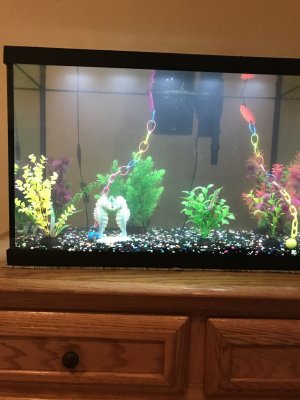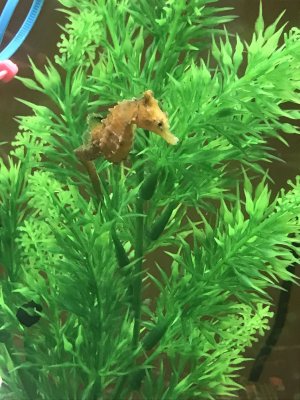Our previous article on Keeping Seahorses in Aquaria focused on how to feed and nourish your ponies. This, our final article in this series, will address how to deal with time away due to travel and also how to handle disease and sickness in your herd.
Now that you know what is necessary to feed seahorses, you are probably coming to the realization that perhaps the teenager next door is not the best choice as a fish sitter!
This is the aspect of seahorse keeping that was my biggest source of consternation when I was considering acquiring them. I have 3 grown children in 3 different states, so I knew I would be travelling. I had to have a plan for the care of my ponies when I went away. Here is how I handle vacations and seahorses.
My plan includes having a person who is acquainted with marine aquaria come once a day. If no such person exists in your world, my plan will not work for you. Many of you, however, are in local fish clubs and that is a good place to find such a person. You can offer to watch over each other’s tanks when you both go away. That is a good arrangement most of the time because it benefits both parties without financial obligations. There are LFS that have employees that you might be able to hire on the side to care for the ponies. This of course requires leaving a key and the trust of the rest of your house in this person’s care. My person is my sister, so I know my house and my seahorses are in good hands when I travel.
Assuming that you have a trustworthy individual to feed your seahorses once a day, you want to make the chore as easy and foolproof as possible for them. I write detailed instructions out on paper and tape that to the tank so they can double check in case they forgot something. I pre-measure the mysis for each day. It is placed in a bathroom Dixie cup with tape over the top. That way one cup and its contents are taken out of the freezer each day. The tank water is added to the cup to thaw. After the food is fed, the cup is thrown away. I have complete control on how much is fed. I have my feeder shrimp tank replenished so that when the ponies’ finish their frozen mysis, then 3 or so live shrimp per pony can be netted from the feeder shrimp for the seahorses to hunt their next meal. This is a fairly reliable way to assure that the tank is not overfed while the ponies are getting enough to eat.
If you do a series of WCs going into your vacation and plan to do another series when you arrive home, your seahorses should be ok for a week’s vacation. If you plan to be gone longer then I would plan for a knowledgeable person to do WCs on the seahorse tank. I always have the water pre-made and circulating in a brute can for WCs.
This can be a nerve-wracking experience but it can usually work. If your lifestyle entails a lot of travel then perhaps the worry associated with travelling and leaving the ponies in another’s care is not worth it. If you only travel occasionally then there is probably a workable solution.
Dealing with Disease and Sickness
When it comes to seahorses, I say an ounce of prevention is worth a pound of cure. Doctoring a sick pony is both emotionally and physically taxing. Remind yourself of this when you feel tempted to skip a WC or skimp on husbandry. The reality is however, even if you are conscientiously keeping seahorses, you will probably at some time be required to treat a sick pony.
The first step is to have a first aid kit on hand to immediately treat a sick seahorse. In most all cases, the quicker a seahorse is treated, the more positive the prognosis. The first aid kit should include a soft pipette and (syringe without a needle) for pouch evacuations or for tube-feeding a sick seahorse. Bio-bandage is a good topical medication if you can find it. I have used Neosporin but it does not stay on the seahorse very well. Anti-bacterial medications like Furan 2, Triple sulfa, tetracycline, and erythromycin are all good to have and most LFS carry them. PraziPro is a good anti-parasitic medication. Kordon Rid Ich Plus which contains formalin is a good anti-fungal or for ecto-parasitic infestation (sometimes it can help with pop-eye). Always have vigorous aeration when using this and check the shelf life, as it can be toxic when it is old. Kordon Methylene Blue is good for reversing ammonia poisoning or relieving respiratory distress. Again, most LFS carry these.
A final medication used for GBD, (gas bubble disease) can’t be gotten at a LFS. It is Diamox, (acetazolamine) and must be obtained with a script from your vet or your family physician. I also understand that it can be purchased online overseas but the quality of the medication can be suspect as it is bypassing certain regulations. There is always the possibility of confiscation by custom’s officials even though this is a legal medication for glaucoma in humans.
When a Seahorse is Beyond Treatment
Unfortunately, there are times when medical intervention is not going to save your beloved pony. This can be especially difficult for seahorse keepers as seahorses often interact with such animation toward their owners. There are really only 2 options for the aquarist. One is to keep your beloved pony as comfortable as possible until the inevitable happens and the other is to gently euthanize the terminal pony with clove oil. This is a personal decision that only the aquarist can make and neither option is easy. As a seahorse owner, it is important that you know ahead of time that you will likely be faced with this dilemma. That won’t take away the pain of loss but at least you will be prepared to deal with it. Also keep in mind that the joy and love they bring to your heart is well worth the risk of loss. Isn’t it that way with anything in life worth having?
Editor’s Note: This brings us to the end of our series on Keeping Seahorses in Aquaria. I hope that in your learning, you’ve caught a bit of the passion that the author holds for these lovable aquatic ponies and that you now feel much more equipped to care for your own herd. Please be sure to share your experiences with us as you start your own pony corral and participate in all the enjoyment that caring for seahorses will bring! If you’d like to share your own adventures with seahorses, or if you have further questions, please be sure to participate in our forum for Seahorse/Pipefish Enthusiasts here on R2R!




















